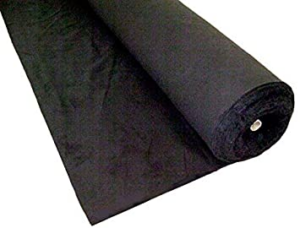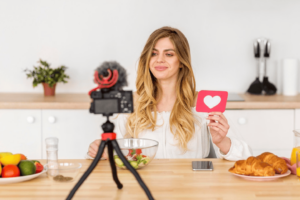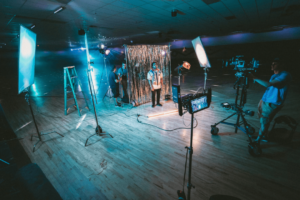Portrait shots are artistic photographs of people that capture the personality of a subject within the image. You need to take several key components into consideration to take good portrait shots, including:
- Pose
- Lighting
- Composition
- Camera settings
- Angle
- Backdrop
Portrait Photography Tips for Mastering the Art
Mastering the art of taking good portrait shots can benefit you as a filmmaker or photographer. Use these tips to improve your skills, and apply them when you practice taking beautiful photographs of your subjects.
Camera Settings:
- Know How To Use Your Camera
Investing in a good DSLR or mirrorless camera and the right lens will help you take better portraits, but you have to know how to use these components. Practice taking photos of various subjects and experiment with the settings to get more familiar with your equipment. Make sure you know how to use the different modes, including manual mode, to gain more control over the photos.
- Choose the Right Lens
The lens you select for shooting portraits will also impact the outcome. If you want to create a more stunning visual effect, a wide-angle lens is the best choice. Additionally, a telephoto lens is one of the most popular tools for shooting breathtaking portrait shots.
- Use RAW Format
Shooting in RAW format gives you more control over the images when it comes to editing and processing.
- Learn How to Focus
A wide aperture alters your depth of field, so focusing is important when you use this tool to take a portrait photograph. Make sure to focus your camera to keep all facial features within focus.
- Use a Wide Aperture
Having a wide aperture is typically the best setting when shooting portraits, with the recommended setting falling somewhere between f/2.8 and f/5.6. You can use this setting to capture a shallower depth of field, which blurs the backdrop to focus more on the subject.
Lighting:
- Adjust the Shutter Speed Settings
When you set the shutter speed of your camera, make sure to factor in the focal length, or the image may be blurry. The shutter speed should be higher than the effective focal length.
- Raise the ISO
When snapping a portrait, your subject may move, blink, or close their eyes. This is especially problematic when you’re photographing kids who have a tough time sitting still. Increase your ISO setting to increase the shutter speed and help prevent motion blur.
- Shoot With a Tripod
A tripod can help you get eye to eye with your subject and maintain better stability for less blur.
- Use the Flash During the Day
You might think that the flash isn’t necessary when you’re shooting outdoors on a sunny day, but that’s actually the best time for it. The sun leads to balancing issues and shadows, so filling the space with your camera’s own light will help balance the exposure and light up your subject.
- Add a Flashgun
Since the flash is so important, you may want to consider adding a flashgun, also known as a speedlight, to your camera when shooting portraits. You can use it to produce a brighter burst of light than what your camera’s flash can provide. Since a flashgun is detachable, you can use it in other places on the shoot to sculpt the light, producing a more professional result.
- Consider a Reflector
A reflector is a tool that many portrait photographers use to brighten the space and use the available light. You can get reflectors with different-colored surfaces to create different lighting settings.
- Adjust the Exposure Compensation
Exposure compensation refers to adjusting the final image to compensate for the amount of light that entered the camera when you shot the photo. If you’re snapping a portrait shot in a frame with extreme light fluctuations, whether dark or light, you may need to adjust the exposure because your camera’s metering system will often struggle.
Composition:
- Design the Color Palette
Designing a color palette before you start shooting can help you create a cohesive visual look and feel. Use colors that complement one another for your subject’s clothing and accessories, props, and backgrounds. You should also consider your subject’s skin complexion when you choose your color palette.
- Select the Right Background
The background of a portrait is almost as important as the subject. A distracting or busy background can detract from the subject, so stick to a neutral or natural backdrop, or look for ways to blur out any distractions.
- Research Unfamiliar Cultures
If you’re photographing someone from a different culture, talk to them and do your own research to understand what is culturally acceptable before you begin.
- Get Creative With Your Compositions
The composition of your photo will play a role in how it looks. Get creative to create unique shots, such as positioning the subject on the side of the frame rather than in the center or adjusting the depth of the field with wider apertures and different lenses.
- Use Props
Including props in your portrait shoot can add flair and increase the visual excitement of the shot. Develop your own signature style with different prop colors, textures, lines, and shapes.
Pose:
- Talk to Your Subject
Even the most experienced subject may struggle when being photographed if you don’t give direction or build rapport. Take time to talk to the person to help them feel more comfortable, and explain what looks you’re trying to capture. You should also provide direction during the shoot.
- Use a Variety of Poses
The position of your subject also impacts the dramatic effect of the portrait. Capture a range of expressions and body positions to see what works best.
- Ensure Proper Exposure on the Face
Since a portrait shot always includes your subject’s face, you want to make sure that the exposure is correct to highlight and emphasize their facial features. An over-lit or under-lit face can look unnatural. Look for ways to enhance the white balance.
- Introduce Movement
A portrait shot is typically still, but introducing some movement can add interest to the photo. Examples include moving the camera or lens, asking your subject to move, or having something in the scene around the subject move.
Angle:
- Get Closer
Get close enough to your subject that you can see their features and expressions. You can adjust the focal length to change the perspective, as well.
- Capture Expressions and Emotions
Taking artistic portraits involves showcasing expression and emotions. Confidence, happiness, and excitement can all come through an image, and these are some of the emotions that photographers should aim to capture when shooting a subject.
- Take Candid Portraits
Many photographers like to shoot candid portraits, which means they have to be unobtrusive and able to be ignored. You should still be friendly and tell your subjects that you plan to shoot them.
- Anticipate Behavior
Knowing your subject well enough to anticipate what they might do next can help you capture some great shots. Watch them carefully and have your camera ready to snap a photo, especially when taking pictures of kids.
- Shoot a Series
Using your camera’s continuous shooting or burst mode captures a series of shots that you can present together or use to choose your favorites.
Learn How To Edit:
The final step in your portrait shooting is properly editing and retouching in the post-processing phase. Use tools to enhance the images, such as Photoshop or Lightroom.
Types of Portrait Shots You Should Be Taking
There are three main types of portrait shots that you can add to your portfolio:
- Headshot
The headshot is a close-up portrait shot that includes the subject’s head and possibly shoulders, and it features the eyes as the main focal point. You can crop a headshot to remove parts of the head or upper body, but it’s important to make sure the cropping looks deliberate rather than an accidental skimming of the top of the head.
- Half Body Shot
The half body shot typically includes at least part of the upper body. It may go to the subject’s waist or only show parts of the upper body, but it differs from the headshot in that at least some of the body is visible.
- Full Body Shot
When taking a full body shot, it’s important to make sure that all parts of the body are visible. The subject can be standing, sitting, or even lying down. A full body shot may encompass some type of motion or action.
To learn more about improving your photography skills and taking better portrait shots, join the Cinema Product Diploma Program at the Nashville Film Institute today.













